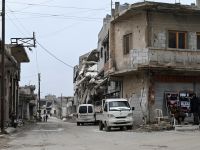Few things conjure nostalgia in the minds of the Lebanese people like the country’s history of train travel. But most of them have never seen a running locomotive in their country, and only one man is left who has ever driven one here: Asaad Namroud.
“I say that a state with no train is no state at all,” Namroud, 91, tells from the porch of his family home in Riyaq, the center of Lebanon’s formerly proud train enterprise. “It was there for the poor, the workers - for everybody. It only brought good.”
Established in 1895, Lebanon’s countrywide train network used to ferry people and goods across its territory and onto the rest of the region.
Many of those railways were destroyed during the 1975-1990 Civil War, and already-aged locomotives fell into disrepair as the conflict made travel among different areas dangerous. When the war ended, reconstruction of the country’s buildings and roadways was prioritized, and in 1992 train travel ceased entirely.
Namroud’s father, a train driver himself, had encouraged his son to submit an application to Lebanon’s train directorate after catching him skipping school.
He recalls a French engineer - “one of those tall and imposing ones” - selecting him for training from among a group of 14 people, despite his young age.
“He said, ‘Viens ici.’ I was 18. It was Oct. 17, 1946. I still remember everything,” he says, his eyes bright. “I got the approval, and I was off.”
Namroud worked on board trains in Lebanon from 1946 until they stopped running - more than 46 years. He learned the trade on the Beirut-Aleppo line, doing backbreaking work clearing tracks after storms or heavy snowfall.
“They got confident in me and moved me to the Damascus line that goes to Deraa and the Jordanian border. I would bring phosphate from there all the way back to Riyaq, and then to Beirut’s port, where the ship would be waiting.”
By 25, he had a locomotive assigned to him.
Not all of his train faring brought back fond memories, though.
His face grows darker as he recalls passing through the now-wrecked train tunnel at Dahr al-Baidar. “Fire and black smoke from the train would hit against the low ceiling, and steam and earth and char covered everyone. It took 20 minutes to get through.
“The doctor would be waiting for us in Riyaq when we came out, to test our lungs. Some of my assistants would cough up blood.”
Still, this does not detract from his memories of taking passengers up by the hundreds to the summit and seeing them hop off to picnic in the snow on a sunny morning.
“Those were the most beautiful days, the best I had. I hope you find days like them too, but all I see now are ugly days,” he says.
Despite having served the state for nearly half a century, Namroud is now poor, unable to even get a test for a cough because it costs $50. He says he had to borrow money to buy Panadol to suppress it so he can sleep at night. “Isn’t this shameful? For me to serve 46 years and six months on the line and live like this now?”
Today, there are several plans to revive railways in Lebanon for the transfer of people and goods. These include lines between Beirut and Tripoli and between Tripoli and Abboudieh, on the Syrian border, with reconstruction of war-torn Syria in mind. But the government has not signed off on funding.
Trains would go a long way toward easing the congestion on Lebanon’s crumbling roads, where travelers spend 50 percent more time than necessary, according to a recently published report by consulting firm McKinsey.
Reports on a study by the European Investment Bank suggest that travel time between Beirut and Tabarja would drop to 15-30 minutes, depending on how often the trains stopped at stations, of which 29 have been proposed. Currently, it can take more than an hour to get from Beirut to Jounieh if traffic is bad, and another hour to drive the 7 kilometers from there to Tabarja.
“Everything is ready, but this issue remains on the shelf for two, four, 20 years, because there is no decision to implement,” Ziad Nasr, the director of the Railways and Public Transport Authority, says. Soft loans for the Tripoli-Abboudieh line were pledged at the CEDRE conference last April, he adds, but the Beirut-Tripoli line, which is much more important for most Lebanese passengers, remains unfunded.
A state-owned Chinese company last year expressed interest in developing the Beirut-Tripoli line, but Nasr says nothing more concrete has happened yet.
Those plans are still a far cry from what Namroud can remember of the days when he would travel through south Lebanon, Damascus, Aleppo and even Turkey. At its peak, Lebanon had over 400 kilometers of tracks. The EIB study reportedly proposes just 86 km, leaving out the south and the Bekaa Valley entirely.
Namroud says the map was closing in around him since he first set off in the first half of the 20th century, reflecting increasing fragmentation in the region. Then, in the ’60s, Syria and Lebanon’s border hardened after the crisis that resulted when Damascus and Egypt merged to form the short-lived United Arab Republic.
“We used to cross all the way to Aleppo and Deraa, but after that we stopped at the border. We’d have the Syrian train take our load, they’d give us theirs, and we didn’t go to Syria anymore,” Namroud says.
Toward the end of Lebanon’s Civil War, he was ordered to reopen the line between Beirut and Jbeil, which like most lines had closed down because of fighting among sectarian militias. “When I arrived, I pulled the horn three times, and people went wild. They ran outside and started clapping, they threw rice at us. After years, they said, ‘The train is back.’”
But in fact, that was one of Namroud’s last rides. Today, when he sees stations in disrepair and train tracks built over, “my heart starts going like this,” he says, making a clenching motion with his hand.
“You know, when I see my machine, I kiss it. My family and children and this house all exist because of that train.”
Inside his small home, the one thing that stands out is a shrine to his train-driving past. He picks up a book on Lebanon’s trains. He is pictured on the front, a handsome young man wearing a black leather jacket, his hair slicked back, standing beside an old locomotive.
From an envelope, he removes his train driver’s license and manuals he had used to study for his exam.
There are also pictures of him with women he met. “She said she wanted to see where I was heading. I said sure,” he recounts, pointing at one photo with a chuckle.
A few minutes from his house, walking through the old Riyaq station, where thousands once labored on trains, Namroud points out a locomotive he parked there in 1976.
“Look at it now, [the Syrian army] broke everything,” he says.
“What a shame.”
The station’s platforms have been without passengers since 1976, the second year of the Civil War, when the Syrian army turned the station into a military base that it held until its 2005 withdrawal from Lebanon.
Large trees grow in the middle of rails and through the wheels of trains, wood sculpted around the discolored iron.
Every step of the way, Namroud recounts a memory, or a curse that he mutters under his breath at those he holds responsible. Here, mortar fire destroyed part of the track.
There, he took his medical test before submitting his application.
“Men of all different religions slept beside each other here, we didn’t even know we were different,” he says while passing a barracks whose roof had caved in. Then he arrives at his old machine. “Look at what they did to you. It’s a good thing my heart doesn’t stop. Curse them.”
Unprompted, Namroud climbs slowly up the rusted ladder into the operating room.
He shuffles over debris to the driver’s window and raises his hand in the air, as if welcoming travelers eager to get on board.
This article has been adapted from its original source.








